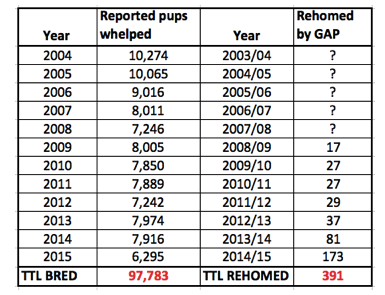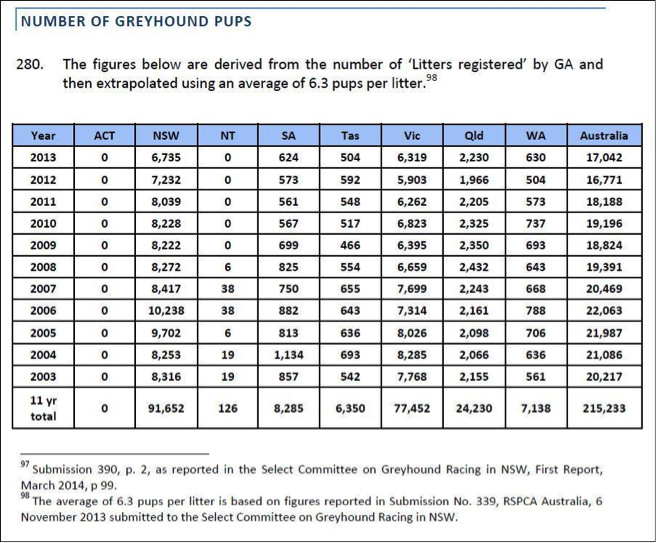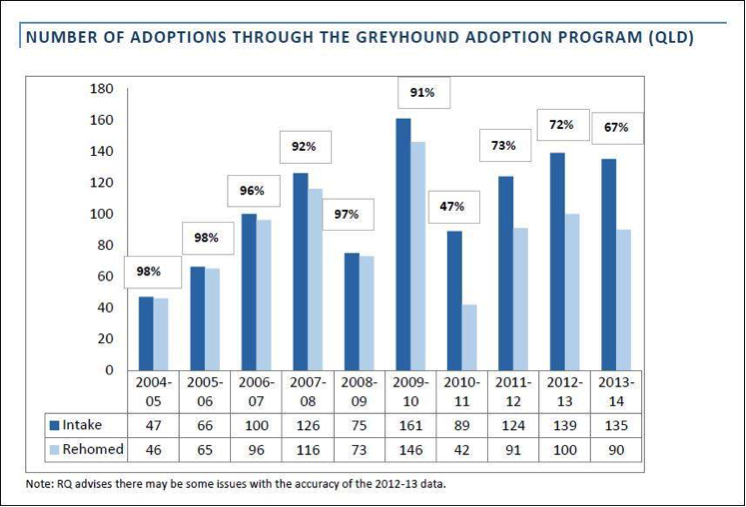The Greyhound Racing Industry in Australia is responsible for the breeding and discarding of thousands of young and healthy dogs every single year. In NSW alone, over the last decade, 97,783 pups were whelped and only 391 were rehomed by the industry adoption program (GAP). See table below.

In its report to the NSW commission of Inquiry, GRNSW indicated that it would not be able to rehome more than 10% of the greyhounds produced by the industry in any single year [1].
In Victoria, the industry has declared that its goal is to rehome 100% of all greyhounds bred by the industry, however, what it has not publicly declared is that it expects 50% of them to be rehomed by volunteers and volunteer groups without any industry support [2].
To Rescue or Not to Rescue?
Some argue that the huge numbers of greyhounds bred every year, desperately needing homes are displacing tens of thousands of other animals who also desperately need a home. Rescuers can never rescue all the greyhounds bred for the industry because the sad reality is that, even though Australia has one of the highest companion animal rates of any country in the world, there will never be enough homes in Australia for every greyhound bred by the industry.
The life span of a greyhound is around 10 to 12 years while the industry breeds thousands of dogs every single year. Even with very basic math ability, it is easy to see that reaching saturation point is inevitable and will come quickly, if the vast majority of greyhounds who are bred are rehomed. So, the proposal of 100% adoption rates as a solution to the industry’s “waste” problem is a ludicrous one at best. It is certainly a disconcertingly deceptive attempt and promoting a more positive public image than the industry deserves.
Nevertheless, rescuing greyhounds who have been discarded by the industry has many positives.
The Positives of Rescuing
The most obvious positive reason for rescuing greyhounds is that, no matter how few or how many dogs are rescued, those who have been saved have escaped an otherwise certain death.
There are many other powerful reasons including that rescue groups and individuals have been at the forefront of:
- bringing attention to the plight of the exploitation of greyhounds in the industry,
and of
- highlighting the beautiful, loyal, and gentle nature of the greyhound breed, once generally believed to be dangerous and aggressive by the general public – largely as a result of the muzzling requirement [3].
So, it is without doubt that greyhound rescue groups have been at the forefront of exposing the industry’s “wastage” and have rescued many more greyhounds from a certain death than the token industry Greyhound Adoption Programs have.
It is also the rescue groups that have mobilized the many Shut It Down rallies that have been held nationwide over the past few years.
Without the exposure that has been mobilized by many rescue groups and rescue individuals, the greyhound industry would find it much easier to continue going about the business of the never ending cycle of breeding, doping, live baiting, racing and killing dogs without any scrutiny, as they did for many decades – 90 years, in fact [4].
The Negatives of Rescuing
Industry Impression Management
On the other hand, it has been argued that rescuing greyhounds helps to enable the industry to keep going by making it look more sustainable. The letter by Paul Archer (see below) makes this point.
Indeed, “looking sustainable” was what the industry Greyhound Adoption Program (GAP) was undoubtedly established to do. The establishment of GAP is little more than a public relations exercise aimed at creating a positive public impression of the industry – making it appear as though the industry cares about the dogs and thereby suppressing potentially negative perceptions about the fate of industry dogs.
The abominably poor adoption record of GAP, highlights that it is a scheme that has never been seriously invested into. It can be surmised that it was never the intention of the industry to seriously invest in it. Its mere existence has served its intended purpose – to improve the public image of the industry, and thereby help it to look sustainable.

To the people who on the frontline of rescuing greyhounds, Archer’s letter is hugely offensive because they see intimately the difference they make to the thousands of dogs whose lives have been saved by them.
However, the general public is unaware of the dedication and persistence of foster carers and rescue groups, taking in one dog after another who is are often traumatized, poorly socialized, or injured.
The public doesn’t see the stress of individuals involved in rescuing, does not see them being pulled in a million different directions trying to deal with trainers who want the greyhounds gone NOW or be killed (to make room for the next lot).
The public doesn’t see them negotiate payment plans with vets for an endless number of dogs.
The public doesn’t see them coordinate volunteers who may or may not be reliable, and juggle doing the charity’s accounts.
The public generally doesn’t know how many hours are poured into fundraising activities to keep these volunteer rescue groups afloat so they can keep rescuing greyhounds discarded by the industry, year after year after year.
So, the industry’s impression management strategy is working.
At the end of the day, all the wider public sees is that greyhounds are being rescued and are now living in loving homes. They don’t see the hard work of volunteer rescue groups who rehome greyhounds without industry funding.
Most importantly, the public is lulled into a sense of security that, at the end of the day, there are rescue groups who save ex-racing dogs from an otherwise certain death.
And the industry is very careful about not exposing the numbers of dogs who are NOT RESCUED – The sheer thousands of them, year after year after year.
The Role of a Biased Media in Upholding the Illusion of a Sustainable Industry
Beginning from when Mike Baird announced the ban in NSW, News Corporation media outlets including The Australian, The Daily Telegraph and 2GB radio station shock jock Ray Hadley mounted a scare campaign to ensure the industry was not shutdown or compromised in any way. One major tactic was to argue that a ban would be killing all of the greyhounds currently in the industry.
The public swallowed it because what was not made clear is that if homes could not be found for those dogs once the shutdown occurred and they were killed, that would be no different to their outcome anyway. The vast majority of dogs bred for the industry are killed when they are no longer of any economic value.
News Corp have now started a scare campaign to compromise the reforms recently announced by GRV and the Andrews government. Again, the argument they are using is that if the industry is compromised – made smaller, dogs will be killed.
Industry Adoption Rates Around the Country
The ACT
In their welfare strategy – November 2015, Canberra Greyhound Racing Club (CGRC) Board of Management (BOM) proposed that “all racing greyhounds must have a ‘life after racing’ and are committed to work towards the development of an on-site facility for re-homing of retired greyhounds” [5].
No mention was made of greyhounds who do not make it as racers.
The ACT Greyhound Support Network (AGSN) has over 500 members, raised over $30,000 for rehoming charities and most importantly – working with registered charities, has helped home 300 greyhounds in the ACT.
Queensland
The MacSporran Report into the Queensland Greyhound Racing Industry revealed that, while approximately 24,230 greyhounds were whelped between 2003 and 2013, the industry through GAP, rehomed only 865 between 2004/05 and 2013/14.


GAP rehomed 230 dogs in 2015/2016. In contrast, the three largest greyhound specific rescues in Queensland rehomed over 330 dogs in 2016 alone. In the six months from 1 July 2016, GAP rehomed 172 dogs with an approximate $50,000 funding injection [6].
South Australia
Greyhound Racing, South Australia’s Annual Report 2015-2016 states that 307 greyhounds were rehomed through GAP. It is claimed in the report that industry participants rehomed 322 themselves. However, this number includes greyhounds kept for breeding and those surrendered to volunteer charity rescues.
GRSA’s plans to realize a “full rehoming strategy for all greyhounds in South Australia by the middle of 2018” and defines full rehoming as excluding “euthanasia undertaken for medical, behavioural or legal reasons only”.
GRSA has also included in their claim that “the South Australian industry, through the collective vehicles of GAP, other rehoming programs and participant placements, will have the collective capacity to rehome more than the 850 greyhounds that it estimates will be required annually to achieve its full rehoming target within the coming two years.” [7]. * Note the bolding is ours.
Tasmania
The Inquiry into Greyhound Racing in Tasmania revealed that 600 to 700 greyhounds are whelped in Tasmania each year, while the number of greyhounds rehomed by GAP in 2014/2015 was 62, an increase from just 35 in 2013/14.
In contrast, the volunteer based charity group, Brightside Farm Sanctuary “has rescued and re-homed over 300 greyhounds” and had taken in 25 greyhounds in one month alone [8, 9].
Western Australia
Racing and Wagering Western Australia’s (RWWA) 2016 Annual Report states they “will aim to have every healthy and behaviourally sound greyhound re-homed” [10].
In 2015/16, 121 greyhounds were adopted through GAP while around 600 are whelped every year. ABC News reported in October 2016, that “one volunteer-run group alone manages to find homes for another 300.” [11].
New South Wales
In chapter 18 of the NSW Commission of Inquiry report it is noted that between 2009 and 2015 the average number of greyhound pups whelped each year was 7,596.
GRNSW’s annual reports reveal that, until 2008, GRNSW had a limited rehoming program.

In the above table taken from the McHugh enquiry, it can be seen that in 2015/16, despite having $436,207.00 revenue which is astronomically more than is the case for small volunteer based rescue groups, GAP NSW only rehomed 202 dogs.
Victoria
The 2015/16 GRV Annual Report states that in 2015/2016, a total of 895 dogs was rehomed through GAP. In this same period, 634 litters were registered with GRV. Assuming 6 pups per litter indicates that in this period alone, 3,804 dogs born and registered with GRV.
With this number of dogs is born in one single year and only 895 dogs rehomed, there remains a large number of dogs needing to be rehomed. The reality is, most are killed.
Conclusion
The greater the number of dogs that is rehomed makes the industry look more sustainable. This is true even though the vast majority of dogs is being rescued by volunteer charity groups and NOT BY THE INDUSTRY.
The reality is that greyhound racing requires a minimum number of dogs to be bred for the industry to continue. This was recently reinforced in an article in The Australian on 19th June, 2017 in which the owners of News Corporation and Punters.com are running a campaign aimed at scaring the Andrews government in Victoria into diluting its recently announced draft code of practice for keeping of greyhounds [12]. This is not surprising, given their vested economic interest in keeping greyhound racing going strong and echoes their 2016 campaign following the NSW ban announcement. In this recent article, it is stated that “there has to be approximately 4000 – 4500 greyhounds born each year to sustain the racing schedule in Victoria of 23 race meetings a week.” [13]
What can we do?
Exposure of industry wastage exposes the industry’s unsustainability.
It was the sheer thousands of healthy, young dogs killed by the industry that nearly brought it down in NSW and is what the industry is now focusing on. The industry needs the public to believe that the dogs are going to nice, loving homes when they “retire” rather than knowing the truth – that most either die on the track or are killed because they are unsuitable for racing or because THERE ARE NOT ENOUGH HOMES IN AUSTRALIA for the sheer thousands of dogs bred for the industry – 4,500 each year in Victoria alone as recently announced in The Australian (see above).
The Baird backflip was brought about in large part by News Corporation propaganda about numbers of greyhounds that would be killed if the ban went ahead and by raising doubts about the number of dogs that the Commission of Inquiry reported are killed by the industry every year.
- The number of dogs killed is a key factor in public digestibility of the industry going ahead or dying.
- Rescuing dogs helps make the industry look sustainable.
Raising the Profile of Rescue Groups
We need to raise the profile of rescue groups and the lives they save but even more importantly, of the lives they can’t save.
It needs to be highlighted to the general public that the unfortunate reality is that greyhound racing breeds roughly 10 – 15 times more dogs ANNUALLY than can realistically be rehomed. Kindhearted volunteers in rescue groups are sadly being exploited to rehome as many dogs as they can, for fear that dogs will otherwise be killed. However, rescuers are at breaking point because of the sheer number of dogs flowing in who cannot be saved.
Meanwhile, the trainers who dump their dogs are relieved of their guilt because volunteers have taken on their problem. For the sanity of kindhearted people, and for moral and ethical reasons, this has to end.
An Industry based on Exploitation.
The public needs to see that the industry is not only exploiting greyhounds, it is also exploiting any individual (e.g., veterinarians, vet nurses) without the heart to leave a dog behind to be killed because its racing days are over or because it was too slow to ever even be raced.
The public needs to see that greyhound racing exploits. It exploits dogs. It exploits small animals used as live bait. It exploits kindhearted people who abhor animal cruelty and it exploits people addicted to gambling.
It has no social license.
It serves no social benefit – rather it cause immense harm to humans and animals.
It must end – Shut It Down!
References
- See p.3 and p.7 of the Inquiry report Vol.1 http://www.greyhoundracinginquiry.justice.nsw.gov.au/Documents/Report-SCI-Greyhound-Racing-Industry-NSW-Volume-1.pdf
- http://www.grv.org.au/about-us/grv-annual-reports/
- http://animalsaustralia.org/features/greyhound-history.php
- https://australianracinggreyhound.com/australian-greyhound-racing/history/australian-greyhound-racing-celebrates-its-90th-anniversary/88127/
- http://docs.wixstatic.com/ugd/2445cf_ec16fb4137014ef09fa87f47b668d733.pdf
- http://www.brisbanetimes.com.au/queensland/greyhound-regulator-cant-rule-out-continued-live-baiting-20170215-gudw2a.html
- https://sa.thedogs.com.au/Uploads/2015_2016%20GRSA%20Annual_Report.pdf
- https://tasracing.com.au/wp-content/uploads/2012/11/TasracingARep_SpreadsWeb.pdf
- http://www.parliament.tas.gov.au/CTEE/Joint/Reports/Final%20Report%20tabled%2014%20September%202016.pdf
- http://www.rwwa.com.au/home/documents/RWWA_AnnualReport_2016_Combined.pdf
- http://www.abc.net.au/news/2016-10-30/rspca-attacks-wa-greyhound-industry-euthanasia-rates/7976544
- http://agriculture.vic.gov.au/pets/dogs/greyhounds/code-of-practice
- Greyhound racing under threat in Victoria: Labor follows lead, and goes for the dogs.
The GAP statistics for Victoria (above) actually understate the problem. The recently-released Regulatory Impact Statement for the Proposed Code of Practice for the Keeping of Racing Greyhounds (2017) contains additional information about GAP’s 2015-16 activities not previously made public.
http://agriculture.vic.gov.au/__data/assets/pdf_file/0005/348278/Greyhound-code-RIS.pdf
Table 8 on Page 32 shows that Victoria’s GAP rehomed 809 greyhounds and approved 36 others for Green Collars, that were rehomed through non-GAP organizations. GAP also “euthanased” 192 greyhounds who had failed to pass their “temperament” tests for adoption suitability. This means that one out of five greyhounds sent to GAP from racing industry participants was killed instead of being rehomed. A footnote to Table 8 indicates that the above three numbers, totalling 1,037 dogs, does not include “returned dogs”, which presumably represents failed adoption placements.
How many “returned dogs” were there? If we look at Table 7 on Page 31 we see a figure of 1,095 dogs retired from the industry through GAP. A footnote tells us that this number “Includes returned dogs / dogs rehomed / third party green collars passed / dogs euthanased at GAP”. The only category mentioned that was not included in the 1,037 dogs calculated above is “returned dogs”. The difference between 1,095 and 1,037 is 58, which is presumably the number of returned dogs. That would represent a failure rate for GAP adoptions of 58 ÷ (809 + 58) = 6.7%, which is high.
Table 7 also shows that 5,538 greyhounds “retired” from the Victorian industry in 2015-16. GAP’s successful “rehoming” of 809 greyhounds represents only 14.6% of those retirees. 2,820 were recorded by the industry as euthanased. Even not including the 192 euthanased by GAP, that means 51% of the industry’s castoff greyhounds that year were killed by the industry itself.